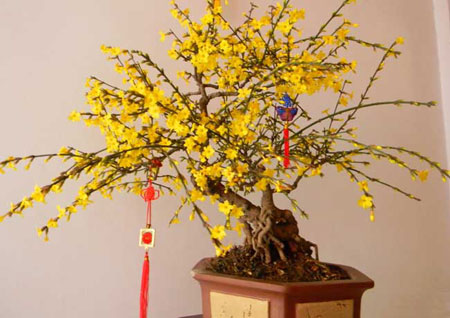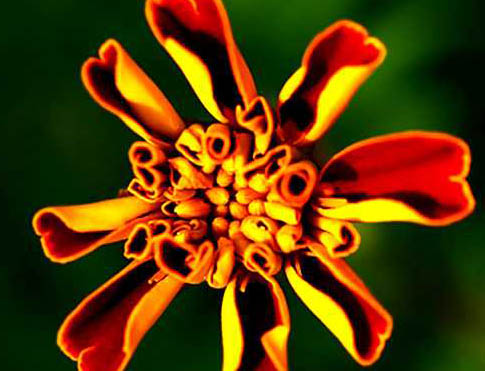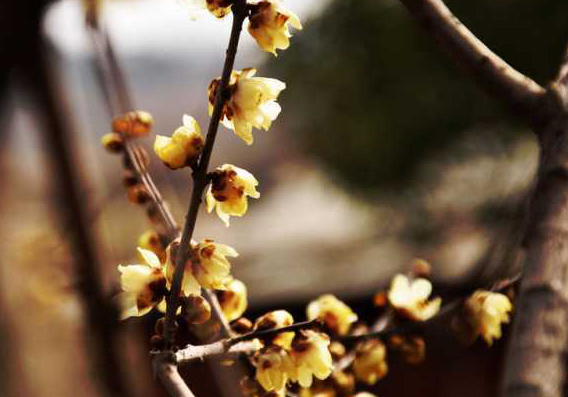How to shape potted preserved plum
Lamei has strong growth, easy to branch and resistant to pruning, so it is suitable for making pile scenery.
The common modeling methods of hanging plum are as follows: in early spring, the old dog tooth plum with "bumps" in the rhizome is planted in a pot, and pay attention to make the part of the "pimples" expose the basin □ or above. After planting, cut off all the branches above the plant, and then wrap it in thin mud mixed with grass to keep it moist and promote the germination of new branches. Leave 4 or 5 sturdy branches after the new branches grow, and cut off the rest. After the quality of the new branch in summer, it will be connected with the wax plum. Pick up the plum which has been pinched and bent in the pot, select the better branches and place them on the top of the "pimple", and then connect the 4-5 branches of Gouya plum on the branches, and separate them from the mother plant after healing. After survival, several thin branches of Prunus mume hold a thicker old branch of Lamei, that is to say, it forms a peculiar hanging plum pile scene with a basin shape.

Wax plum likes to be wet and afraid of waterlogging.
There is an agricultural proverb, "Wintersweet that cannot die in drought". Watering should be "dry and wet". If the basin soil is not dry, it should be watered thoroughly. Under normal circumstances, water is watered once a day in spring and autumn, sprayed every day at 8-9 a.m. in summer, and watered thoroughly in the afternoon and evening. From June to July, the water evaporates quickly and the leaf transpiration is also fast, which is the period of flower bud formation, so watering should be sufficient. If the water is insufficient, the leaves are easy to become dry yellow and affect the formation of flower buds. But in winter to control watering can be watered at noon every 4-6 days, the amount of water is not much. The amount of water should be reduced again after defoliation, which can be watered every 7-10 days. Before flowering and in full bloom, watering should be appropriate, and the water is easy to fall buds. If there is little water, the flowers will bloom unevenly. In particular, the basin soil proposed here cannot accumulate water. in case of a storm, the basin should be moved indoors or covered with plastic film to prevent long-term water storage in the basin.
Timely pruning
There is a proverb that "there is no shortage of branches of wax plum". Before sending the leaves after the flower fades, combined with the styling, it should be heavily trimmed once. Cut off withered branches, overdense branches, cross branches, medial branches and diseased weak branches. Leave two or three pairs of buds at the base of the branches in a year, and cut off the upper branches to promote new shoots. At the same time, when pruning, pay attention to the replacement of old branches, with 2012 branches instead of aging branches. If it is not renewed in time, the flowers will be small and small, and after every two or three pairs of leaves grow on the new branches, the coring will be carried out 2-3 times to promote more short and strong branches, so that the plant shape is symmetrical and beautiful. In the process of pruning and coring, if there is no need to stretch branches in every direction of the plant shape, the buds should be peeled off in time. It is often observed from April to June to do a good job of pruning, coring and wiping buds, otherwise it is easy to produce a lot of overgrown branches, consume nutrients, and it is difficult to form flower buds. After July, the plant shape has been finalized, if sprouting and branching again, it should be removed in time to transport nutrients to the flower buds.
Preparation of basin soil
Chimonanthus potted, potted soil preparation is very important. Due to the small capacity of flowerpots and soil storage, there should be a standard for the preparation of potted soil: first, the pH should be suitable. If the sulfur concentration of strongly acidic soil is higher than that of root cell fluid, the root hair can not absorb water, but make the cell fluid seep into the basin soil, resulting in the loss of water and atrophy of Chimonanthus praecox pile root and death. Second, the nutrients should be rich. The prepared basin soil should be fertile, good drainage and air permeability, strong ability to retain water and fertilizer, and the contents of organic matter and various nutrients are required to meet the needs of growth and development of Chimonanthus mume stump, leafy branches, bud and flowering. Third, the structure of aggregates should be better. The prepared potted soil requires aggregates ranging in thickness from rapeseed to pea. The structure of the basin soil is good, which can make the water, fertilizer, gas and heat conditions of the basin soil suitable and coordinate the supply. According to the above standards, the preparation of wax plum basin soil can be carried out according to the following formula: 3 parts of rotten leaf soil, 3 parts of vegetable garden soil, 2 parts of coarse sand soil, 2 parts of coal ash soil, mix well and disinfect. The easiest way is to expose yourself to the sun and freeze. It can also be treated by pot steaming, or stir-frying or burning soil ash, so that most harmful germs, pests and weed seeds in the basin soil are killed, and the loose soil after disinfection is beneficial to the growth and development of Chimonanthus praecox.
Wax plum likes to be fat
According to the above criteria, loose and fertile basin soil was selected. Ching Ming Festival watered thickly rotten human and animal manure before. When the leaves grew from April to May, mature thin human and animal fertilizer or rotten cake fertilizer was applied every two weeks or so to promote the formation of flower buds. The period from June to July is the period of flower bud differentiation and flower bud formation of new shoots, and then apply liquid phosphorus and potassium fertilizer for 1-2 times. Should not be too thick, so as not to cause yellow leaves and fallen leaves. White Dew should apply thicker fertilizer again after autumn to enrich the flower buds. Before winter, apply 1-2 times of mature thin manure for human and animal to provide nutrients for flowering. Water should be irrigated every other day after each fertilization, and the soil should be loosened in time to keep the basin soil well ventilated.
Potted Chimonanthus praecox coincidentally overheat
Raise potted wintersweet, always should not be taken lightly, when the summer high temperature sunburn, slightly careless, light cause thin flowers, reduce the ornamental value of pile scenery; serious cause the whole plant withered, so that the ancient pile Chimonanthus cultivated for many years will be destroyed. According to years of maintenance and specific environmental conditions and the particularity of Chimonanthus chinensis. The following techniques can be used to maintain. First, cover basin moisturizing. Use pots larger than potted plants, or bamboo baskets or wooden boxes containing fruit, place potted Cuomei in them, then fill the bottom and surroundings of pots and bamboo baskets with rotten leaf soil or loose soil, then use a few small tiles or plastic to roll into a large ring, fix them on the inner edge of the upper mouth of the set, and use rope or lead wire to make tiles. The plastic ring is firmly fastened and filled with loose culture soil, so that the base of the dragon claw-shaped lateral root exposed on the winterberry is buried together, which can prevent the summer sun exposure and maintain the humidity and heat resistance around the Wintersweet potted plant. Second, the cover is humidified. When it is hot in the summer, you can increase humidity by covering up substances that are not easy to emit water, such as rotten leaves, rice bran ash, rags, old cotton and so on. These substances absorb enough water at one time, at least keep potted wintersweet in a moist state within two days during high temperature and drought, so as to ensure that the stakes on the balcony of dry areas or high-rise buildings will not lose water and die because the air is too dry. Third, shade and moisturizing. Wax plum like semi-shade, in the hot summer, sunburn at noon, can be shaded or moved into a shady place.
- Prev

Conservation principles of malachite grass
The maintenance principles of malachite grass are as follows: (1) the light regulates that the malachite grass is a positive plant, which requires sufficient sunlight for growth and flowering, and sufficient light is also helpful to prevent the overgrowth of plants. Avoid direct sunlight in the hot season and cool down by shading around noon. (2) the temperature can be reduced by 18 degrees Celsius after temperature control.
- Next

How to prune potted preserved plum
Wax plum has strong branches, and it can sprout more stout flower branches through pruning, and it can blossom more. Pruning should be carried out after the flowers fade and before the leaves. Because pruning is too late, it is easy to grow branches, which consumes nutrients and water, resulting in poor flower bud differentiation and affecting flowering. The method of pruning is to sparse and cut the dead branches first.
Related
- Fuxing push coffee new agricultural production and marketing class: lack of small-scale processing plants
- Jujube rice field leisure farm deep ploughing Yilan for five years to create a space for organic food and play
- Nongyu Farm-A trial of organic papaya for brave women with advanced technology
- Four points for attention in the prevention and control of diseases and insect pests of edible fungi
- How to add nutrient solution to Edible Fungi
- Is there any good way to control edible fungus mites?
- Open Inoculation Technology of Edible Fungi
- Is there any clever way to use fertilizer for edible fungus in winter?
- What agents are used to kill the pathogens of edible fungi in the mushroom shed?
- Rapid drying of Edible Fungi

